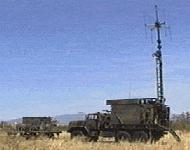




The Trailblazer AN/TSQ-138 is a mobile, groundbased electronic warfare signals intelligence (EW/SIGINT) intercept system with VHF direction finding (DF) capability. It is used as a tactical direction finding and intercept system providing support to the tactical commander. It is mounted in the shelter of a tracked vehicle which tows a trailer support unit. Authorized level of distribution is for five TRAILBLAZER systems to be assigned to each heavy division. The system is used to search for, intercept, record, identify, locate, and report on radio signals in the HF/VHF/UHF frequency ranges. Trailblazer is capable of performing netted direction finding operations with other Trailblazers and various other platforms. The system interoperates with the airborne QUICKFIX system for direction finding.
The Trailblazer Master Control Group consists of five AN/TSQ-138A Master Control Sets (MCS), and is organic to a heavy division military intelligence battalion. Each MCS is mounted on a M923A2 5-ton carrier. A Trailer Support Unit, which houses a 30 kilowatt generator is the primary power source for the MCS. The MCS and all it's electronic equipment is housed in an S-661 shelter. A quick erecting, self supporting telescopic mast for the DF antenna group, and separate antennas for HF intercept and voice link are attached to the top of the shelter. The shelter has a ballistically protected exterior to resist small arms fire. The MCS operator is capable of intercepting and monitoring signals in the HF, VHF, and UHF frequency bands. The MCS operator determines the locations of signal emitters by intercepting and analyzing signals of interest in the VHF band. DF tasking and other communications between MCSs are controlled by a secure data link.
| Description |
|
| Crew |
|
| Deployment |
|
| Features |
|
A Major TRAILBLAZER deployment considerations for successful operations are Primarily LOS to target area of interest for effective VHF monitoring. LOS between the each TRAILBLAZER set for effective data link communications.(an effective DF baseline) Freedom from obstacles which may interfere with antenna emplacement or reception (power lines, pine trees, 30 feet (10 meters) clear to the left, overhead tree clearance) Protection from enemy fires and EW. Secondary considerations are LOS between the master, or at least one TRAILBLAZER and the ACE for effective reporting link communications (if not employ TIGER relay).
For effective VHF monitoring, the antenna group must have a clear LOS to the target area of interest. The NCS should also have a clear LOS to each station for effective data link communications. Careful selection of a suitable collection site free of obstructions greatly enhances TRAILBLAZER's operational capabilities. In the event that terrain is not available to provide direct line of sight between the TRAILBLAZER NCS and all TRAILBLAZER responses can be relayed by other OSs, or by the AN/ALQ-151(V)2 QUICKFIX helicopter borne system when it is operating in the TRAILBLAZER DF net.
Normally VHF signal reception is not affected by the ground over which the signals travel. However, signals can be affected by objects in their wave path or obstructions in the near vicinity of a TRAILBLAZER set. Some examples of objects which can affect signal reception are barbed wire, armored vehicles, surrounding hills, trees, and streams. Any metallic bodies located close to a TRAILBLAZER set can produce DF inaccuracies from that location. This includes RADAR scattering camouflage.
Reporting will almost always be done through the UHF net radio protocol (NRP). However, this is a rather slow and inefficient system. If any squad has an extremely perishable report, or one that involves possible surprise on a friendly unit or use of NBC by the enemy, it would be reported immediately to the Platoon Leader over VHF radio. A standard report would also be sent to MMC, but extremely perishable intelligence needs to be sent to the affected unit.


